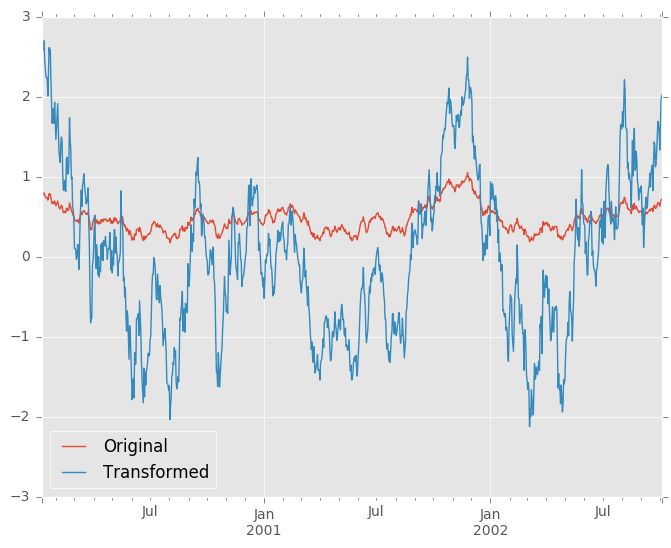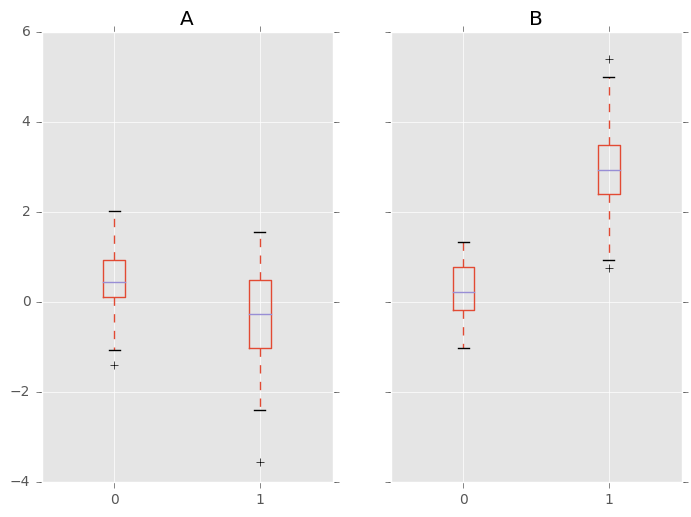Transformation
transform方法返回一个对象,其索引与被分组的对象相同(大小相同)。因此,传递的变换函数应返回与组块大小相同的结果。例如,假设我们希望标准化每个组中的数据:
In [66]: index = pd.date_range('10/1/1999', periods=1100)
In [67]: ts = pd.Series(np.random.normal(0.5, 2, 1100), index)
In [68]: ts = ts.rolling(window=100,min_periods=100).mean().dropna()
In [69]: ts.head()
Out[69]:
2000-01-08 0.779333
2000-01-09 0.778852
2000-01-10 0.786476
2000-01-11 0.782797
2000-01-12 0.798110
Freq: D, dtype: float64
In [70]: ts.tail()
Out[70]:
2002-09-30 0.660294
2002-10-01 0.631095
2002-10-02 0.673601
2002-10-03 0.709213
2002-10-04 0.719369
Freq: D, dtype: float64
In [71]: key = lambda x: x.year
In [72]: zscore = lambda x: (x - x.mean()) / x.std()
In [73]: transformed = ts.groupby(key).transform(zscore)
我们期望结果现在在每个组内具有平均值0和标准偏差1,这可以容易地检查:
# Original Data
In [74]: grouped = ts.groupby(key)
In [75]: grouped.mean()
Out[75]:
2000 0.442441
2001 0.526246
2002 0.459365
dtype: float64
In [76]: grouped.std()
Out[76]:
2000 0.131752
2001 0.210945
2002 0.128753
dtype: float64
# Transformed Data
In [77]: grouped_trans = transformed.groupby(key)
In [78]: grouped_trans.mean()
Out[78]:
2000 1.168208e-15
2001 1.454544e-15
2002 1.726657e-15
dtype: float64
In [79]: grouped_trans.std()
Out[79]:
2000 1.0
2001 1.0
2002 1.0
dtype: float64
我们还可以直观地比较原始数据集和转换后的数据集。
In [80]: compare = pd.DataFrame({'Original': ts, 'Transformed': transformed})
In [81]: compare.plot()
Out[81]: <matplotlib.axes._subplots.AxesSubplot at 0x7ff26ffe62d0>

另一个常见的数据转换是用群平均替换丢失的数据。
In [82]: data_df
Out[82]:
A B C
0 1.539708 -1.166480 0.533026
1 1.302092 -0.505754 NaN
2 -0.371983 1.104803 -0.651520
3 -1.309622 1.118697 -1.161657
4 -1.924296 0.396437 0.812436
5 0.815643 0.367816 -0.469478
6 -0.030651 1.376106 -0.645129
.. ... ... ...
993 0.012359 0.554602 -1.976159
994 0.042312 -1.628835 1.013822
995 -0.093110 0.683847 -0.774753
996 -0.185043 1.438572 NaN
997 -0.394469 -0.642343 0.011374
998 -1.174126 1.857148 NaN
999 0.234564 0.517098 0.393534
[1000 rows x 3 columns]
In [83]: countries = np.array(['US', 'UK', 'GR', 'JP'])
In [84]: key = countries[np.random.randint(0, 4, 1000)]
In [85]: grouped = data_df.groupby(key)
# Non-NA count in each group
In [86]: grouped.count()
Out[86]:
A B C
GR 209 217 189
JP 240 255 217
UK 216 231 193
US 239 250 217
In [87]: f = lambda x: x.fillna(x.mean())
In [88]: transformed = grouped.transform(f)
我们可以验证组平均值在变换的数据中没有变化,并且变换的数据不包含NA。
In [89]: grouped_trans = transformed.groupby(key)
In [90]: grouped.mean() # original group means
Out[90]:
A B C
GR -0.098371 -0.015420 0.068053
JP 0.069025 0.023100 -0.077324
UK 0.034069 -0.052580 -0.116525
US 0.058664 -0.020399 0.028603
In [91]: grouped_trans.mean() # transformation did not change group means
Out[91]:
A B C
GR -0.098371 -0.015420 0.068053
JP 0.069025 0.023100 -0.077324
UK 0.034069 -0.052580 -0.116525
US 0.058664 -0.020399 0.028603
In [92]: grouped.count() # original has some missing data points
Out[92]:
A B C
GR 209 217 189
JP 240 255 217
UK 216 231 193
US 239 250 217
In [93]: grouped_trans.count() # counts after transformation
Out[93]:
A B C
GR 228 228 228
JP 267 267 267
UK 247 247 247
US 258 258 258
In [94]: grouped_trans.size() # Verify non-NA count equals group size
Out[94]:
GR 228
JP 267
UK 247
US 258
dtype: int64
注意
一些函数应用于groupby对象时将自动变换输入,返回与原始形状相同的对象。传递as_index=False不会影响这些转换方法。
例如:fillna, ffill, bfill, shift。
In [95]: grouped.ffill()
Out[95]:
A B C
0 1.539708 -1.166480 0.533026
1 1.302092 -0.505754 0.533026
2 -0.371983 1.104803 -0.651520
3 -1.309622 1.118697 -1.161657
4 -1.924296 0.396437 0.812436
5 0.815643 0.367816 -0.469478
6 -0.030651 1.376106 -0.645129
.. ... ... ...
993 0.012359 0.554602 -1.976159
994 0.042312 -1.628835 1.013822
995 -0.093110 0.683847 -0.774753
996 -0.185043 1.438572 -0.774753
997 -0.394469 -0.642343 0.011374
998 -1.174126 1.857148 -0.774753
999 0.234564 0.517098 0.393534
[1000 rows x 3 columns]
New syntax to window and resample operations
版本0.18.1中的新功能。
使用对groupby级别的重采样,扩展或滚动操作,需要应用辅助函数。然而,现在可以使用resample(),expanding()和rolling()作为groupbys上的方法。
下面的示例将基于列A的组对列B的样本应用rolling()方法。
In [96]: df_re = pd.DataFrame({'A': [1] * 10 + [5] * 10,
....: 'B': np.arange(20)})
....:
In [97]: df_re
Out[97]:
A B
0 1 0
1 1 1
2 1 2
3 1 3
4 1 4
5 1 5
6 1 6
.. .. ..
13 5 13
14 5 14
15 5 15
16 5 16
17 5 17
18 5 18
19 5 19
[20 rows x 2 columns]
In [98]: df_re.groupby('A').rolling(4).B.mean()
Out[98]:
A
1 0 NaN
1 NaN
2 NaN
3 1.5
4 2.5
5 3.5
6 4.5
...
5 13 11.5
14 12.5
15 13.5
16 14.5
17 15.5
18 16.5
19 17.5
Name: B, dtype: float64
expanding()方法将为每个特定组的所有成员累积给定操作(在示例中为sum())。
In [99]: df_re.groupby('A').expanding().sum()
Out[99]:
A B
A
1 0 1.0 0.0
1 2.0 1.0
2 3.0 3.0
3 4.0 6.0
4 5.0 10.0
5 6.0 15.0
6 7.0 21.0
... ... ...
5 13 20.0 46.0
14 25.0 60.0
15 30.0 75.0
16 35.0 91.0
17 40.0 108.0
18 45.0 126.0
19 50.0 145.0
[20 rows x 2 columns]
假设您要使用resample()方法来获取每个数据帧的每日频率,并希望使用ffill()方法完成缺少的值。
In [100]: df_re = pd.DataFrame({'date': pd.date_range(start='2016-01-01',
.....: periods=4,
.....: freq='W'),
.....: 'group': [1, 1, 2, 2],
.....: 'val': [5, 6, 7, 8]}).set_index('date')
.....:
In [101]: df_re
Out[101]:
group val
date
2016-01-03 1 5
2016-01-10 1 6
2016-01-17 2 7
2016-01-24 2 8
In [102]: df_re.groupby('group').resample('1D').ffill()
Out[102]:
group val
group date
1 2016-01-03 1 5
2016-01-04 1 5
2016-01-05 1 5
2016-01-06 1 5
2016-01-07 1 5
2016-01-08 1 5
2016-01-09 1 5
... ... ...
2 2016-01-18 2 7
2016-01-19 2 7
2016-01-20 2 7
2016-01-21 2 7
2016-01-22 2 7
2016-01-23 2 7
2016-01-24 2 8
[16 rows x 2 columns]
